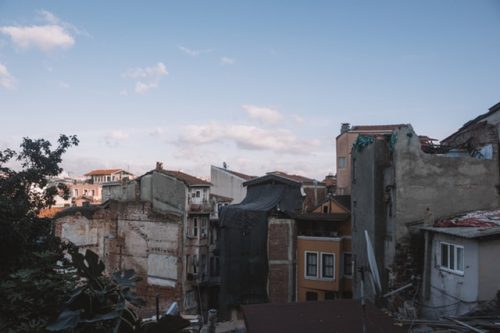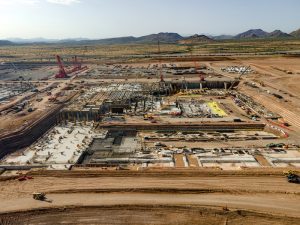Natural disasters affect nearly 160 million people worldwide, according to the World Health Organization. They include earthquakes, hurricanes, tornadoes, wildfires, droughts, floods, and more. As well as damaging people’s lives and the environment, they can also direly affect businesses. Here’s how to explore angles of before, during, and after the disaster hits.
Disaster Planning
Besides having an evacuation plan, people take stock of what they have, or don’t.
For instance, amid the recent earthquakes in Southern California, Los Angeles residents, fearing The Big One, stocked up on earthquake survival kits, which include basic first aid supplies, emergency signal flares, non-perishable food items, and a battery-powered radio. Local hardware stores in Los Angeles took to stocking earthquake kits after the Ridgecrest earthquake; they quickly sold out.
Local hardware and camping stores, such as Lowe’s, Home Depot, or REI, may report an increase of survival supplies. Also look into grocery stores to see if people are getting supplies or foodstuffs. For other disasters that include flooding, there are also emergency sandbags. (Afterwards, however, these emergency supplies require clean-up and disposal.)
For tornadoes and hurricanes, some decide to stick it out with storm shelters, which can be built below or above ground. Check out businesses that advertise bunkers for both residential and commercial areas.
How do businesses prepare for natural disasters?
On the business side, readiness is paramount, starting with insurance. There are two insurance policies a business owner should consider, a Businessowners Policy (BOP) or a Commercial Multiple Peril (CMP), according to the Insurance Information Institute. The former is more expensive and less comprehensive, but it includes “business interruption coverage,” which reimburses for losses during a disaster (hurricanes, tornadoes, and wildfires) or while the business is shut down for repairs. However, neither of these options include earthquake insurance, which must be purchased separately.
FEMA advises that businesses plan how to notify their employees, customers, and stakeholders if an emergency occurs, as well as account for electricity and equipment shortages or breakdowns. FEMA also suggests safe-guarding important records, such as insurance and employee contracts, as well as confidential software and hardware inventory.
More facts and statistics on individual disasters and insurance can be found on iii.org.
Do businesses lower or raise prices after a natural disaster?
If businesses choose to stay open during a disaster, there’s often this debate. However, is it price-gouging or a calculated business decision?
Harvard Business Review advocates for businesses to lower their prices during natural disasters, arguing that it is, first, the right thing to do. As a bonus, the decision maintains customer loyalty and boosts its reputation as an altruistic brand. However, on the other side, the Cato Institute warns that maintaining low prices encourages hoarding and stockpiling, lowering the supply for people who cannot afford to do so. In addition, low prices also signal to customers that everything is fine, misleading them and suppliers seeking to replenish their stocks.
Nowadays, the Internet makes it easier for people to call out companies for raising prices, such as with Twitter users accusing Delta Airlines of price gouging for evacuees fleeing Hurricane Irma in 2017. This led to Sens. Richard Blumenthal and Edward J. Markey writing to Transportation Secretary Elaine Chao for an investigation on these reports.
Clean-up and recovery after a natural disaster
Afterwards, there’s much recovery to be done to the affected surrounding properties and environment. Companies such as Paul Davis clean “mold and smoke damage from emergencies ranging from mundane water-heater leaks to multibillion-dollar fires, floods, and hurricanes.” After the Woolsey Fire in November 2018, it was busy cleaning out smoke damage from homes and businesses. Are there companies in your area that repair such damages? Also look into charitable and individual efforts post-disaster.
Meanwhile, the waste and recycling industry has a part to play in the clean-up. For instance, after Hurricane Matthew devastated much of the East Coast and Caribbean, major companies such as Waste Management collected garbage and recycling materials, asking residents to take steps such as separating storm debris from regular household refuse. Collection services took as long as a week. (Prior to the storm, waste and recycling collection services and operations were suspended.)
These companies typically work with government emergency management officials, according to Waste360.com. The most common form of debris are yard, food, and landscape waste; as recovery happens, construction and household damages are added to the mix. Think of the costs to remove the debris, as well as considering alternative forms, such as medical waste from hospitals and emergency set-ups, as well as environmental waste, which can include mud, slurry, fallen trees, ash, and rubble from the disaster, according to WHO. The organization also includes the need to collect human waste.
OSHA has a manual on procedures cleaning up waste after natural disasters.
Moving forward after a natural disaster
According to FEMA, very few businesses spend time on contingency plans post-disaster; more than of small businesses fail unless they can “resume operations within 5 days.” How do businesses in your area recover, and how many go under?
How do natural disasters affect tourism? Countries like the Carribean and Mexico consider tourism an important source of income, especially from North American travelers, but were badly damaged in Hurricanes Irma and Maria. Tourists stayed away as a result. In some places, tourism recovers quickly and not much income is lost, such as with Napa Valley after the fires.
However, some wish to see the damage up close, as part of a niche community known as “disaster tourists.” Although perceived by critics as crass and exploitative, people retain fascination for sites damaged by natural disasters, from volcanoes (one of the most famous examples is Pompeii) to Chernobyl. Travelers can visit the damaged areas, hit by Hurricane Katrina and tornadoes of Joplin, Missouri. While not without controversy, proponents see these as opportunities for education and help to rebuild.










